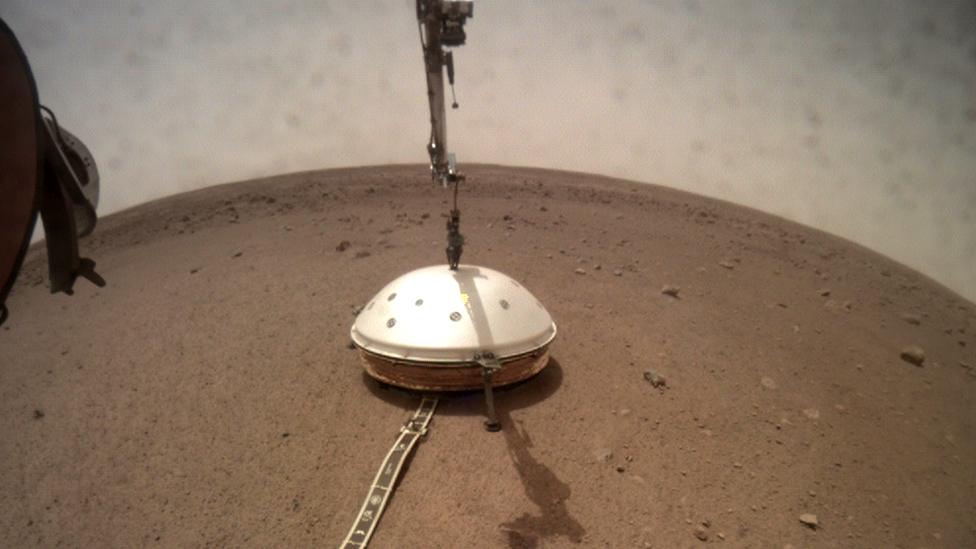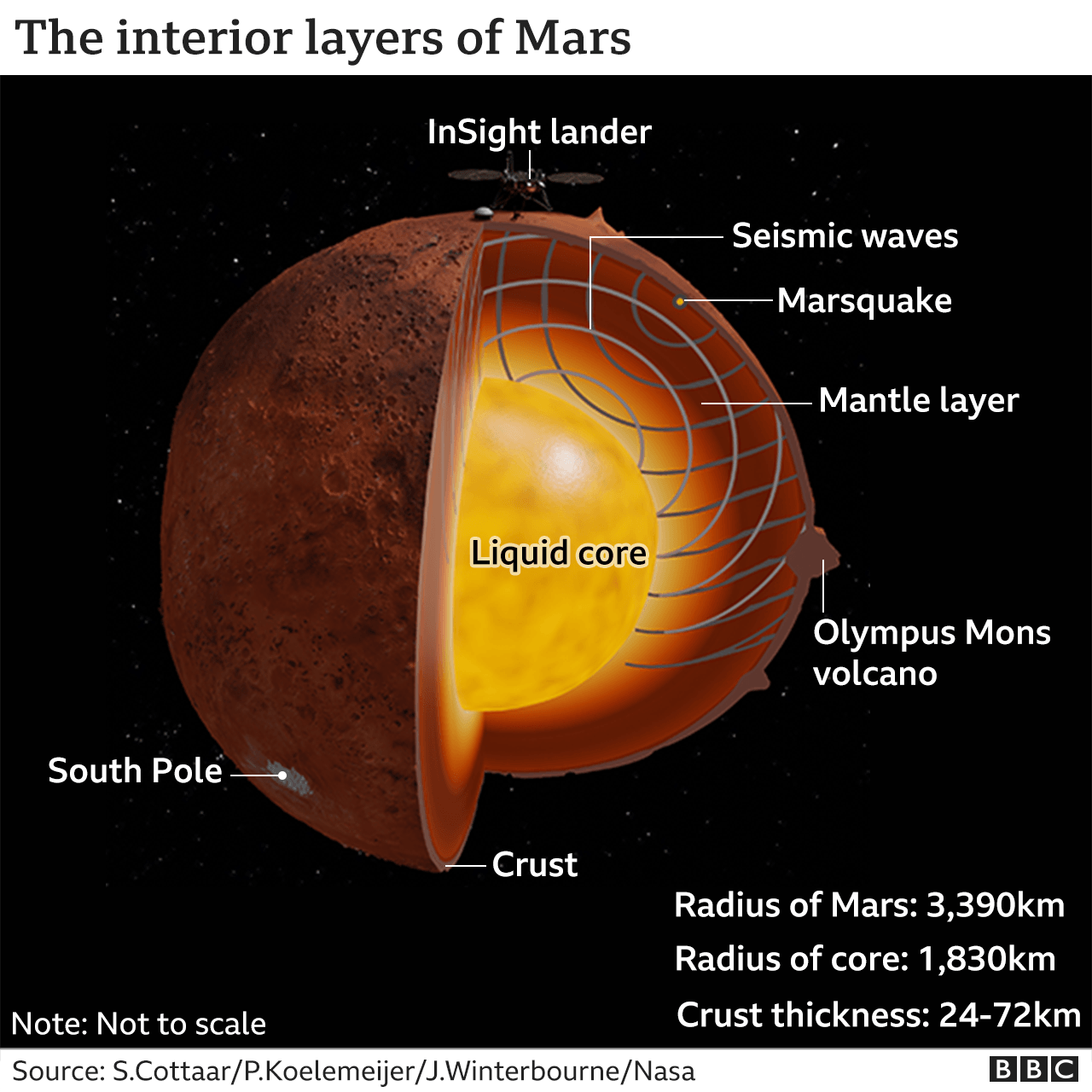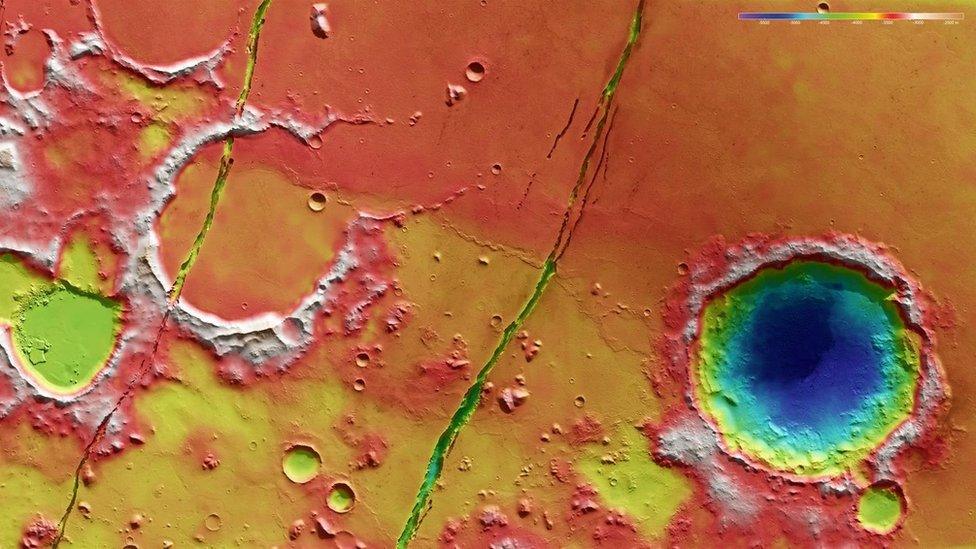Nasa InSight: 'Marsquake' mission in its last months
- Published

The sophisticated French-UK seismometer package is just weeks away from being shut off
The seismometer on Nasa's InSight probe will keep listening for Marsquakes even as other systems on the mission have to shut down due to declining power levels.
The spacecraft has just detected a Magnitude 5 tremor - the biggest event yet in its three years of operation on the Red Planet.
But InSight is now picking up very little energy through its solar panels.
Dust covers the arrays, and winter is approaching.
Lower light levels will signal the end of the mission.
Equipment, such as the probe's robotic arm, is about to be locked in position and turned off.
The all-important seismometer can be put in a reduced working mode for a while, coming on for only part of a Martian day, or Sol, and then perhaps only every other day. Mission managers will keep this up for as long as they can, but they know time is not on their side.
"[In July] we anticipate our seismometer to be turned off, not because we want to turn it off but unfortunately we don't have the energy to run it," said Kathya Zamora Garcia, InSight's deputy project manager at the US space agency's Jet Propulsion Laboratory (JPL) in Pasadena, California.
"At the end of the calendar year, we do anticipate having to conclude all InSight operations," she told reporters.

The mission, which landed in a flat landscape known as Elysium Planitia in 2018, has transformed our understanding of the interior of the Red Planet.
Before its sophisticated French-UK seismometer package began returning data, we had a "really fuzzy picture" of how Mars' different layers were organised.
Now, after using the vibrations from more than 1,300 Marsquakes to "image" the planet's deep geology, scientists can be much more certain about the thickness and composition of the planet's crust, mantle and core.
"What InSight has done is shone a light on the inside of Mars," said principal investigator Bruce Banerdt, also from JPL.
"Whereas we know a lot about the outside of Mars - we've taken images, we've taken spectra, we've made measurements of the surface of Mars for the last 50 years - InSight's been the first mission to shine a light beneath the surface of Mars and show us what the rest of the planet looks like."

Scientists knew that at some point Martian dust would settle on InSight's solar wings to block out the Sun's rays.
It's the perennial blight against which all solar-panelled missions to the Red Planet must battle.
When InSight touched down on 26 November 2018, its black-coloured, sparkling clear wings were producing about 5,000 Watt hours per sol. Today, coloured red from all the dust, they can produce only one-tenth as much at approximately 500 Watt hours per sol.
"We use an electric oven as a marker to get people to understand," said Zamora Garcia. "So, when we first landed, it was about an hour, 40 minutes or so where we could run an electric oven. Nowadays, we could probably run that for approximately 10 minutes max."
Ingenious efforts have been made to try to clean the wings. InSight has a scoop and by sprinkling dust on to the wings, it had the effect of knocking off some of the dust already in place. The trick has been used successfully six times to extend operations, but it won't save the mission.
Scientists will hope InSight can add a few more events to its tally of 1,313 detected Marsquakes. Who knows, they may even get to see another Magnitude 5 before everything on the mission shuts down.
The M5 was detected on the Martian morning of 4 May. For context, a tremor of that scale here on Earth would definitely be noticed and might even cause some minor damage to loosely constructed buildings.
Mission team-members are still analysing the data but they think the Marsquake occurred close to, but not exactly in, a region of the planet called Cerberus Fossae.

The rocks of Cerberus Fossae have extensive faulting, making the region a major source of quakes
Cerberus Fossae, which is about 1,500km to the east of InSight's location, has been the source for all of the bigger tremors witnessed by the probe.
The terrain there is heavily faulted as a result of past volcanic activity on Mars. Two huge parallel fissures run across the landscape for 1,000km.
The vast majority of quakes on Mars likely stem from thermal anomalies in the crust. As the planet cools and shrinks, its rocks will break along lines of weakness, releasing the seismic waves InSight's seismometer was designed to pick up.
"InSight has been an incredible mission for us, and it's given us a glimpse of Mars that we couldn't get from any other spacecraft in our Nasa Mars fleet," said Lori Glaze, the director of Nasa’s planetary science division.
"Understanding Mars and studying Mars' interior structure answers key questions about the early formation of the rocky planets in our inner Solar System, including Mercury, Venus, Earth, Earth's Moon, and Mars, as well as helping us understand rocky [planets beyond our Solar System]."
